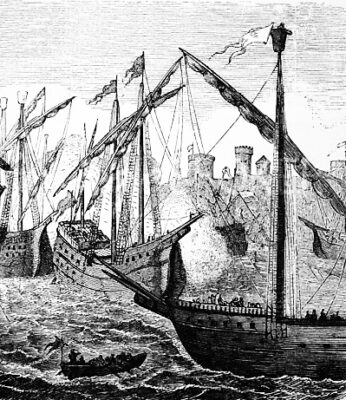Puberty
In June 1397 the union of the three kingdoms became official with the crowning of the new king in the cathedral of Kalmar in the southeast of modern-day Sweden with Margaret continuing to be the de facto ruler of the Scandinavian Kingdom until she died in 1412. A year later Eric made himself master of Copenhagen which after the death of Valdemar VI in 1375 had passed under the control of the bishop of Roskilde, yet again.
Eric forced Roskilde’s chapter to renounce its claims on Copenhagen, exactly as Valdemar had done before him. In 1417 King Eric officially took possession of the new castle (which would later evolve into Christiansborg Slot) built on the ruins of Absalon’s first castle, sealing the primacy of the crown over the church in the city of Havn.



War with Hansa continued well into the 1420s. When King Eric introduced a new toll for all foreign ships passing the Øresund in 1426, six Hanseatic cities (Hamburg, Lübeck, Lüneburg, Rostock, Stralsund, and Wismar) declared war and put a naval blockade on Scandinavian harbors. The first naval battle in the Øresund in 1427 was won by the joint Dano-Swedish fleet but a year later, Hansa’s ships sailed towards Copenhagen where the fleet had anchored and the city was besieged. Eric fled the castle leaving back his wife Queen Philippa to manage the defense against 260 ships and 12.000 mercenaries.
With a combination of land-based artillery and a counter-attack by the Dano-Swedish fleet, the Hanseatic league ships were forced to retreat in April 1428. In June of 1428 however the Hanseats returned to Copenhagen and this time, although their forces were cut in half, the attack was successful. Most of the King’s ships were sunk, destroyed, or damaged. Only three ships were able to escape unscathed. It would be the start of the end for King Eric of Pomerania. By 1439 all three kingdoms of the Kalmar Union had declared him deposed.



Christopher of Bavaria ascended to the Danish throne in 1440. In 1442 he was proclaimed king in all three kingdoms. A year later his royal residence in Roskilde was destroyed by fire and Christopher moved his seat to the Copenhagen castle, making the city the official capital of the Danish kingdom in 1443. Christopher of Bavaria died in 1448 without natural heirs and the union of the three kingdoms broke up again.
The Riksråd, a national council of magnates and nobles offered the throne to count Christian of Oldenburg under the condition that he would marry the widow of his predecessor. He became the first king of Denmark to be crowned in Copenhagen’s cathedral in 1449. The first in a long line of rulers from the Oldenburg dynasty that would rule Denmark until 1863.




